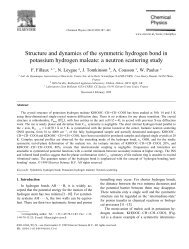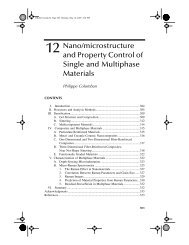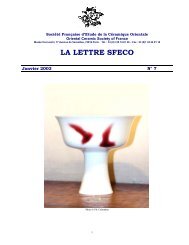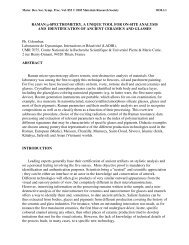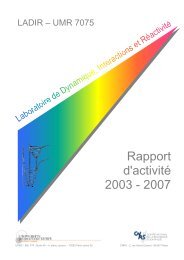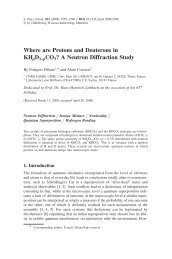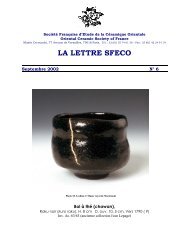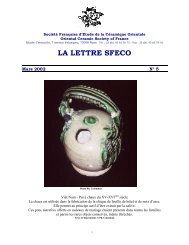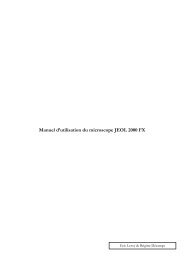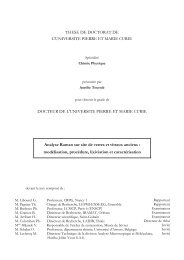Raman Spectroscopy of nanomaterials - institut de chimie et des ...
Raman Spectroscopy of nanomaterials - institut de chimie et des ...
Raman Spectroscopy of nanomaterials - institut de chimie et des ...
Create successful ePaper yourself
Turn your PDF publications into a flip-book with our unique Google optimized e-Paper software.
ARTICLE IN PRESS+ MODELG. Goua<strong>de</strong>c, Ph. Colomban / Progress in Crystal Growth and Characterization <strong>of</strong> Materialsxx (2007) 1e563.1. Phase i<strong>de</strong>ntification and phase transitions in nanoparticles11In many <strong>nanomaterials</strong>, the <strong>Raman</strong> spectrum remains sufficiently similar to that <strong>of</strong> the correspondingsingle crystal to facilitate direct i<strong>de</strong>ntification <strong>of</strong> the phases [28,32,129e145]. Onc<strong>et</strong>he <strong>Raman</strong> spectra are known, phase transitions can be characterized (transition temperature,transition pressure, transition or<strong>de</strong>r) through mo<strong>de</strong> variation, much the same way as in bulk materials[92,137,146e158]. Besi<strong>de</strong>s, the observation <strong>of</strong> any theor<strong>et</strong>ically forbid<strong>de</strong>n mo<strong>de</strong> isa very sensitive probe <strong>of</strong> lattice distortions [131,159].Barborini <strong>et</strong> al. [157] showed with RS that the structure <strong>of</strong> gas phase-<strong>de</strong>posited TiO 2 clustersturned from rutile to anatase whenever they reached 5 nm in diam<strong>et</strong>er. A difference in surfaceenergy usually plays a <strong>de</strong>terminant role in such a phenomenon, as proposed a long time ago byGarvie [160] for zirconia. Similarly, Fray and Payne [158] showed how the temperature <strong>of</strong> theorthorhombic-t<strong>et</strong>ragonal phase transition <strong>of</strong> BaTiO 3 ceramics <strong>de</strong>pends on the grain size.3.2. Analysis <strong>of</strong> amorphous nanodomainsMicro-<strong>Raman</strong> <strong>Spectroscopy</strong> is som<strong>et</strong>imes more powerful than X-ray analysis for <strong>de</strong>tectingand monitoring crystallisation/amorphisation processes in covalent materials [92,100,146,161e164]. Of course, both crystallographers and <strong>Raman</strong> spectroscopists characterize disor<strong>de</strong>rthrough peak broa<strong>de</strong>ning. Y<strong>et</strong>, while a loss <strong>of</strong> long distance translational periodicity (<strong>of</strong> highatomic number atoms) is always associated with broa<strong>de</strong>ning for diffraction patterns, only latticeand librational (R 0 ,T 0 ) mo<strong>de</strong>s are sensitive to the same ‘‘long distance’’ disor<strong>de</strong>r in RS [165].The width <strong>of</strong> the other <strong>Raman</strong> mo<strong>de</strong>s is mainly sensitive to the ‘‘local’’ crystal field, more specificallyto the short range or<strong>de</strong>r in the first (0.1e0.5 nm) and second (0.5e5 nm) atomic shells.If the ‘‘molecular’’ <strong>de</strong>scription <strong>of</strong> vibrations applies (see Section 2.6), then <strong>Raman</strong> bendingmo<strong>de</strong>s are even specifically sensitive to local geom<strong>et</strong>ric disorientation and <strong>Raman</strong> str<strong>et</strong>chingmo<strong>de</strong>s to the neighbouring disor<strong>de</strong>r (particularly atoms from other sublattices or electric <strong>de</strong>fectsresulting from substitutions/vacancies).In fact, diffraction discriminates ‘‘periodical’’ domains from ‘‘disor<strong>de</strong>red’’ ones but does noteasily differentiate clear-cut separations in the real space and progressive orientational disor<strong>de</strong>rs(para-crystal), especially in strongly covalent structures such as organic and inorganicpolymers [166, p. 615e620]. In materials, mainly polymers, which present interlocking submicronic‘‘crystalline’’ and ‘‘amorphous’’ conformational domains [167e174], the distinction issom<strong>et</strong>imes possible using mRS. The simplest way to picture the problem is to fit lattice mo<strong>de</strong>swith two components, one representing the amorphous state and the other the crystalline state.The area ratio <strong>of</strong> the two un<strong>de</strong>rlying areas yields a good estimate <strong>of</strong> the crystallinity [175,176].Fig. 5 illustrates this point with a spectrum <strong>of</strong> the polyami<strong>de</strong> 6.6 fibre. The polarization analysisclearly shows the orientational effect <strong>of</strong> straining (fibre extrusion) on the nanocrystals whereasthe specific analysis <strong>of</strong> the low frequency components, which show the collective chain movements,facilitates the separate analysis <strong>of</strong> the amorphous (wi<strong>de</strong> Gaussian band) and crystalline(narrow Lorentzian) phases. These results were used to <strong>de</strong>monstrate that the mechanical fatigue<strong>of</strong> the fibres results from the progressive transformation <strong>of</strong> the amorphous phase [169,170,172].Nanophase separation was also investigated in glasses where the connectivity <strong>of</strong> constitutivepolyhedra s<strong>et</strong>s the wavenumbers [177]. Some bands could be attributed to <strong>de</strong>finite clusters incomparison with the experimental spectra <strong>of</strong> reference crystalline phases [177] or first principleDensity Functional Theory (DFT) calculations [94,178].Please cite this article in press as: G. Goua<strong>de</strong>c, Ph. Colomban, Prog. Cryst. Growth Charact. Mater. (2007),doi:10.1016/j.pcrysgrow.2007.01.001



